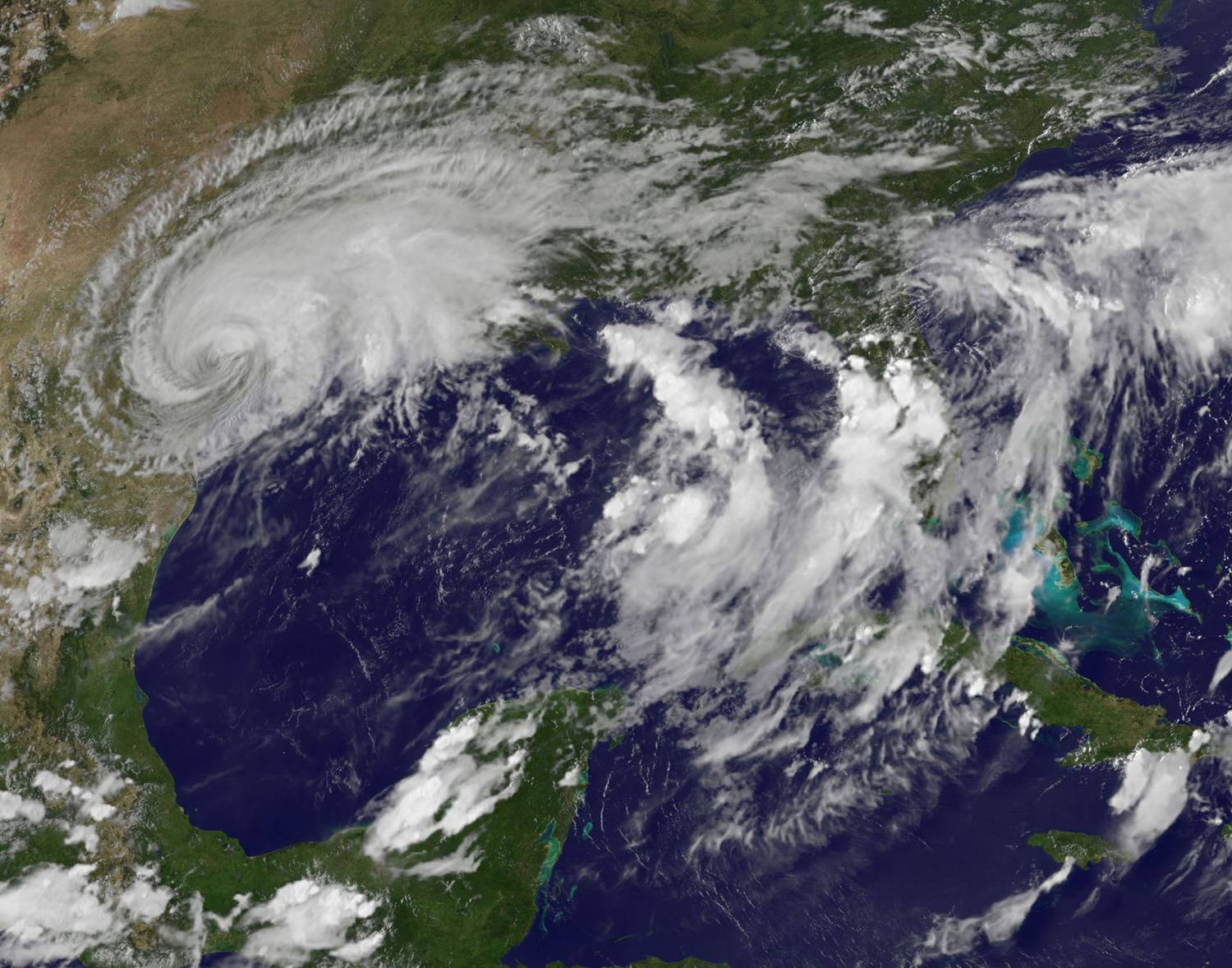Good morning. Here’s our morning roundup of all the media news you need to know. Want to get this briefing in your inbox every morning? Subscribe here.
Long before CNN morphed into Trump TV, Jeff Flock was its most estimable and high-profile chronicler of natural, if not political disasters. There he was, the indefatigable and steady presence in a flapping nylon windbreaker or billowy parka, perhaps grasping a Florida cypress tree or North Carolina light pole for dear life.
So knock on wood that Flock, now a Chicago-based FOX Business Network stalwart, is thrown back into his old specialty that began with Hurricane Gilbert in 1988. For a cable junkie, it’s like Floyd Mayweather coming out of retirement. And for those searching to understand the changes in media coverage symbolized by Hurricane Harvey, he’s a goldmine.
“Nasty flooding,” said a man Sunday who knows about nasty flooding and is dispatched to Houston.
As for what we’re now consuming from journalists, technology makes all the difference, he says. Small live packs, like the LiveU units he using at Fox, “enable you to move around and see what’s really going on and transmit that in real-time. In old days we’d have to hunker down with a big satellite truck out of the wind. Usually that meant you were at a hotel and on a beach.”
Now, as one can see, there’s greater flexibility among journalists. The TV folks, especially, can move around Houston and report in ways they couldn’t once upon a time in similar conditions.
“The other thing is that technology has essentially made a photographer/reporter out of the whole populace,” said Flock, one of CNN’s first reporters in 1980. “We now get as many compelling pictures out of the general public as we do from professional journalists (that pic of elderly folks in a nursing home in waist deep water is pretty amazing, for example).”
It’s that transformation (which can also bring unedited chaos) that, Flock said, may well make it far easier to understand how bad the situation is than was the case in the early days of 2005’s Hurricane Katrina. Or with 1988’s Gilbert, then the most powerful hurricane recorded in the Atlantic basin, replete with 185-mile per hour winds.
Remember, he notes, that it actually took a while before Katrina’s true scope was perceived (“You’re doing a heckuva job, Brownie,” President George W. Bush said famously to FEMA administrator Michael Brown). “It will be harder to be slow on the uptake with this one,” Flock said.
So it was no surprise that Harvey was above-the-fold front-page news throughout Texas. (Poynter) “State of Destruction” was the succinct banner of the Houston Chronicle. A Houston independent journalist’s weather website was a must-read for many (Poynter); the Weather Channel warned of catastrophic flooding to persist (Weather Channel); and the power of old-fashioned still-images remained powerful in one long montage. (Texas Monthly)
There were appropriate first-person tales of journalists themselves, such as that of New York Times reporter Clifford Krauss (“the home that I saved my entire career to buy is flooding fast…”). And there were numerous references to the Houston TV reporters who continued their coverage despite the need to abandon their stations. (Poynter)
The three most prominent national newspapers — The New York Times, Washington Post and Wall Street Journal — ditched their paywalls so readers could consume their coverage for free. Amid its strong coverage, the Houston Chronicle made its eNewspaper available for those with print delivery issues since Harvey, it noted, “may result in hazardous road conditions causing a delay to delivery of newspapers.”
But one was also reminded that there were other things going on in the world and that the news-making decisions of many outlets were different than the cable news channels and national papers such as The Times and Washington Post. As usual now, cable news largely focused on the one story (though MSNBC returned to its normal Sunday night features fare via a two-hour documentary on the late Princess Diana).
By and large, it was the proportionality of their hurricane coverage that was strikingly different. They didn’t discount its importance; they merely reflected other concerns of their consumers, who aren’t all glued to cable news, especially during the waning days of summer, as I was also reminded anecdotally at a neighborhood block party in Chicago.
By late Sunday afternoon, the Miami Herald was giving far greater play to local baseball star Giancarlo Stanton hitting his 50th home run. (Miami Herald) The hurricane coverage at that moment was merely the 16th story on its site, reporting an elite squad from Florida heading to help. Such local angles drove the Detroit Free Press’ “Hurricane Harvey, Houston floods hit home for Lions’ Glover Quin,” a story about a football player’s response to events back home. (Free Press)
KPIX, the CBS station in San Francisco, led with several thousand marching in Berkeley in a “March Against Hate.” Curiously, it was the same with the Portland Oregonian.
Most prominently featured in late afternoon on The Arizona Republic site was a tale on Labor Day weekend getaways in Arizona.
Watching early television Monday in Chicago, the disjoint was manifested in local television outlets whose total local audience far outpaces the three major news channels (just one show, the “WGN Morning News,” beat them all easily).
CNN, Fox and MSNBC were dominated by either Harvey or Trump coverage (“Morning Joe” went heavy on the Friday-night “news dump” of Trump signing a transgender military ban, pardoning the notorious former Arizona sheriff Joe Arpaio and dumping combative aide Sebastian Gorka). CNN quickly made a big Harvey question all about — who else? — Trump (“Trump faces the natural disaster test”) as historian Doug Brinkley was beckoned to speculate.
But the likes of WGN (Tribune, soon Sinclair), WLS (ABC), WMAQ (NBC) and WBBM (CBS) in Chicago included a far greater variety of mostly local stories, sports, traffic and weather. Harvey didn’t come close to dominating coverage. If it’s not of immediate personal concern, people are engaged with many other matters, especially as vacation season winds down.
And while Breitbart News, which has been one of President Trump’s favorite windows on the world, had a conspicuous tale on “Harvey havoc,” the site back under the control of dismissed Trump aide Steve Bannon gave far bigger play to some seeming political score-settling:
Amid the destruction in Houston and elsewhere, it was a definition of the fake news reviled by Bannon and his onetime West Wing patron.
CBS upends Aussie media moguls
“U.S. media company CBS Corp. plans to acquire Australian broadcaster Ten Network Holdings Ltd, beating out a bid from Australian media moguls Bruce Gordon and Lachlan Murdoch for the company after it went into receivership.” (The Wall Street Journal)
“The purchase marks a significant step for the U.S. company, which is expanding its international business by agreeing to new content licensing deals with foreign broadcasters and launching its own streaming services overseas.” (The Financial Times)
Good local enterprise
The Chicago Sun-Times disclosed that one-third of the City of Chicago workforce earned more than $100,000 last year. (Sun-Times)
Thirty-six earned more than Mayor Rahm Emanuel’s $216,210, including (my favorites) two undercover police sergeants who each earned more than $250,000.
What does Facebook hiring mean?
Facebook hired former New York Times public editor Liz Spayd to help manage how the giant can offer more “transparency” in its decision-making. (Recode)
Facebook still isn’t producing content, with its media folks having two apparent tasks: Find even more media companies to provide actual content and to convince a larger world that it means well.
For the moment, as with the hiring of former TV reporter-anchor Campbell Brown, it’s hard not to wonder if the Spayd move is by and large window dressing. But, perhaps, it turns out to be much more, at least somewhere down the road.
Help in figuring out data plans
If you’re a normal human being, even with a graduate degree or two, you might still be forever confused by wireless pricing solicitations and plans. Check out USA Today’s tech podcast where Jefferson Graham interviews colleague Robert Pegoraro when it comes to Verizon’s new unlimited data” plans.
What’s the best plan for you to get? It depends on how much data one uses, with most people able to do just fine with five gigabytes. Pegoraro thinks that for the average user, Verizon can be a good deal but that the good deal is “really well-hidden” in its offerings and is way cheaper than its unlimited offering. Among unlettered plans, he’s partial to T-Mobile.
Oops
It don’t come easy. But The Milwaukee Journal Sentinel conceded, “A story in Friday’s Journal Sentinel on Jerry Kramer being nominated for the Pro Football Hall of Fame incorrectly named Ringo Starr as a center for the Packers instead of Jim Ringo.” It was quickly tweeted out by Milwaukee-based media blogger Jim Romenesko.
Kramer wrote the 1969 best-selling diary 1969 “Instant Replay” with the help of the late, great Dick Schaap, whose son Jeremy is an ESPN stalwart.
Corrections? Tips? Please email me: jwarren@poynter.org. Would you like to get this roundup emailed to you every morning? Sign up here.






